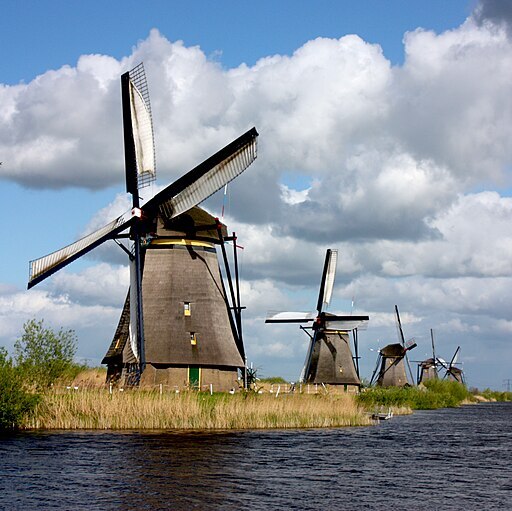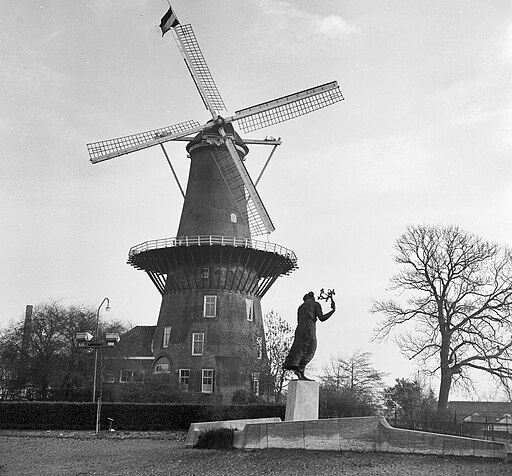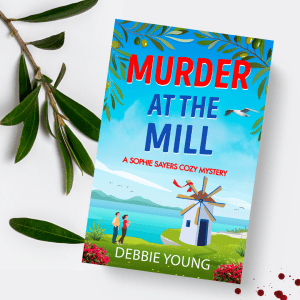Blowing in the Wind
What’s not to love about windmills? From children’s toys to towering turbines, I shared my views in this article for the February issue of the Hawkesbury Parish News.
Summitting a local hill on a clear morning in early January, I am surprised to spot in the distance a wind turbine that seems to have materialised from nowhere. Did a local farmer hang up an extra-large stocking on Christmas Eve, so Santa could leave him one as a present?
These days so many wind turbines seem to spring up overnight that it’s hard to keep track of the new arrivals, especially as they all look the same: soaring white towers topped by three long, narrow blades. Not that I mind, because I find them attractive and soothing to watch.
Only when I plant a child’s toy windmill in my garden do I realise how different its habits are from a wind turbine’s. Although positioned for maximum exposure, a wind turbine’s blades either turn at a steady pace in the same direction, or else they’re stock still. (Apparently too much wind can be dangerous, so in gales they’re turned off for safety reasons.)
Not so my toy windmill. In my relatively sheltered garden, its blue plastic sails whiz round so fast they form a blur. Changing direction every few seconds, they turn just as quickly either way, regardless of the prevailing wind.
As an instrument of meteorological observation, my toy windmill is about as reliable as the rain gauge I’ve sunk into the soil beside it. This calibrated plastic cone often shows negative rain. How can rainfall reduce as the day goes by? Evaporation alone can’t account for such a discrepancy.
Can rain really fall in reverse?
I solve the mystery when I spot our cat Bertie enjoying a long drink from it. He soon designates the rain gauge his favourite al fresco drinking station. It certainly looks more appetising than his previous preferred outdoor water source, our murky garden pond.
Wondering how wind turbines work leads me down a fascinating rabbit-hole online. I learn how gearing and other technical tricks evolved from early wind-powered machines installed by the Ancient Romans in Egypt. I then spin off at a tangent to investigate the use of traditional Dutch windmills for signalling.
 Photo of Kinderdijk Windmills, Netherlands (a UNESCO World Heritage site), by Willard84, CC BY 3.0 <https://creativecommons.org/licenses/by/3.0>, via Wikimedia Commons
Photo of Kinderdijk Windmills, Netherlands (a UNESCO World Heritage site), by Willard84, CC BY 3.0 <https://creativecommons.org/licenses/by/3.0>, via Wikimedia CommonsHistorically in the Netherlands windmill sails were locked into particular positions to convey messages to the local community. + meant the mill was open for business, x that it was closed. The top sail at 1 o’clock denoted a healthy birth, whereas 11 o’clock indicated a death. During World War II, sail settings issued silent warnings to the local population, such as of the arrival of Nazi search parties seeking Jews.
 Photo of Dutch windmill with sails in mourning position for Queen Wilhelmina, 1962 Rijksdienst voor het Cultureel Erfgoed, CC BY-SA 4.0 <https://creativecommons.org/licenses/by-sa/4.0>, via Wikimedia Commons
Photo of Dutch windmill with sails in mourning position for Queen Wilhelmina, 1962 Rijksdienst voor het Cultureel Erfgoed, CC BY-SA 4.0 <https://creativecommons.org/licenses/by-sa/4.0>, via Wikimedia Commons The tradition continues: in July 2014, when 198 Dutch passengers were killed in the attack on Malaysian Airlines Flight MH17, windmills across the Netherlands set their sails in the mourning position to show respect for those who lost their lives.
The only problem with my new-found knowledge is that next time I see an immobile wind turbine, I’ll wonder what it’s trying to tell me.
When Windmills Can Mean Murder… Join Sophie Sayers for a trip to a sunny Greek island in spring
Join Sophie Sayers for a trip to a sunny Greek island in springIf you also love windmills, you might like to try my sixth Sophie Sayers cosy mystery, Murder at the Mill (originally published as Murder Your Darlings).
In this story, aspiring writer Sophie Sayers travels in the spring to a tiny Greek island to join a writers’ retreat. It’s to be led by bestselling romantic novelist Marina Milanese – but then she goes missing on a solitary stroll to a derelict clifftop windmill. First on the scene of Marina’s disappearance, Sophie soon finds herself accused of murder, and must work fast to solve the mystery before the local police can arrive from the mainland.
This lighthearted, feel-good mystery introduces a lively group of eccentric authors, plus colourful Greek characters from the holiday hotel. Not to mention the elusive monks in the local monastery…
It’ll also make you feel as if you’ve had a Greek island retreat of your own!
Murder at the Mill is available to order in ebook, paperback, audio and large print, from wherever you prefer to buy your books.



